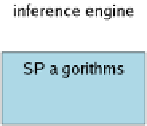Information Technology Reference
In-Depth Information
Fig. 6.
The pilot architecture for the monitoring system Calicot.
of decision rules. The first one selects a detection algorithm, the second one selects the
abstraction level that must be used for chronicles:
if
paced
and
noiseType=muscular
and
noiseLevel
≤
0dB
then
algo df2
if
PWaveDetection is active
and
QRSClassification is active
then
abstractionLevel=4
8
Machine Learning
In our approach machine learning is used at two stages: i) for learning chronicles and
ii) for learning decision rules for the pilot module. To establish accurate diagnoses ef-
ficiently the chronicles should be as discriminating as possible, i.e. they should clearly
distinguish the diseases. However, the specification of discriminating chronicles is hard
to do manually. Moreover, as first order (temporal) relations are concerned, we have
chosen to use a machine learning method that can cope with logical relations and nu-
merical temporal constraints. Inductive logic programming (ILP) satisfies these require-
ments [25]. From examples describing symbolically signals related to disorder episodes,
ILP induces a set of first-order clauses that can discriminate the classes to which the
examples belong. Fortunately, one such clause can be translated straightforwardly to a
chronicle for CRS. In addition, by varying the language bias, i.e. the description lan-
guage of examples and clauses, and using related background knowledge, models at
different abstraction levels can be learned (see [3]). Furthermore, the model space can
be explored efficiently by searching only the most promising parts. In this context, we
have proposed a method for learning efficiently from multisource data [12].
The goal of decision rules is to aid the pilot module select the best algorithm and
chronicle set according to the current signal and patient context. We have used two
approaches to devise such rules. The first one makes use of PCA (Principal Component

















































































Search WWH ::

Custom Search